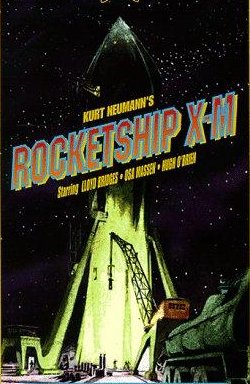Previous FilmRobot-Girl Nr. 1
Next FilmRocky Jones - Crash of the moons
Rocketship X-M 1950
 | An astronaut crew on their way to the Moon are unexpectedly propelled by gravitational forces and end up on Mars instead. |
The Cast
| Lloyd Bridges | - | Col. Floyd Graham |
| Osa Massen | - | Dr. Lisa Van Horn |
| John Emery | - | Dr. Karl Eckstrom |
| Noah Beery Jr. | - | Maj. William Corrigan |
| Hugh O'Brian | - | Harry Chamberlain |
| Morris Ankrum | - | Dr. Ralph Fleming |
| Patrick Aherne | - | Reporter #1 |
| Sherry Moreland | - | Martian Girl |
Film Trivia
This movie contained a sequence showing the consequences of atomic war on Mars, and how it had destroyed the once advanced Martian civilization. This is one of the first times a movie showed the dangers of atomic war, and might have actually been the first.
In the 1970s businessman Wade Williams acquired the rights to this film and proceeded to produce new special effects sequences to take the place of the film's original effects scenes. New shots included a model of the rocket in space, sequences depicting the ship descending toward and taking off from Mars, re-filmed sequences on Mars with new actors, and the use of stock footage of an actual nighttime rocket take-off in the launch sequence at the start of the movie. These sequences were substituted for original footage that was cut from the film, and were seen on the initial VHS and DVD releases in the US. In the 1990s, however, much of this substitute footage was removed and the original scenes restored. The only remaining updated effects sequences occur in the initial launch from Earth, and shots of the rocket landing on and departing from Mars (all of which used stock footage of a V-2 rocket in the original). However, the complete, uncut, original version of the film remains unavailable.
The gravity-assist method of achieving escape velocity shown is similar to the one actually used in 2013 by India's Mars Orbiter Mission to leave Earth for Mars.
The original trailer for this film emphasized the fact that it was the first film involving space travel. It was in theaters more than three weeks before the first showings of George Pal's Destination Moon (1950).
When the film was originally released theatrically in 1950, the sequences on Mars were tinted red so as to impart a sense of the alien Red Planet into the black-and-white film. But subsequent TV prints did not reproduce this effect, and for decades the Martian scenes were shown only in black-and-white until the red tint was restored for home video in the early 1980s.
The location where the crew exits the spacecraft and begins to explore is Zabriski Point in Death Valley National Park.
The musical score by Ferde Grofé Sr. was the first time a theremin was used in a science-fiction movie.
When George Pal announced production of his space epic Destination Moon (1950) this film was rushed into production to capitalize on it and beat Pal's film into theaters by several weeks.
One of the correspondents is played by Judd Holdren, who would soon be part of the new space craze himself in the title role of the serial Captain Video, Master of the Stratosphere (1951).
Promotional material sent to exhibitors carried the disclaimer "This is not 'Destination Moon'."
The film underwent several changes in concept before finally being filmed as it is. Initially, producer-director Kurt Neumann wanted to make a movie about an expedition to Mars that encounters living dinosaurs, but producer Robert L. Lippert rejected the script. Around the same time, special effects man Jack Rabin approached Lippert with a script about a space flight to the moon, to be called "Destination Moon". Producer George Pal, however, had just copyrighted that title for his own picture about a lunar mission--Destination Moon (1950)--but Lippert changed his mind and, to take advantage of the publicity for Pal's "Destination Moon", brought Neumann's and Rabin's ideas together for his own film about a spaceflight to the moon. Subsequent threats of legal action from Pal forced Lippert to change the venue of his film from the moon back to the planet Mars--the locale in Neumann's original script.
This was Lloyd Bridges's first of two films featuring a manned mission to the Moon. The other is Stowaway to the Moon (1975).
On the Sea Hunt (1958) story 'Underwater Ejection', Lloyd Bridges is working with a rocket scientist on a series of launches codenamed X-M.
The film was originally to have been entitled "None Came Back", but writer-producer-director Kurt Neumann changed it to "Rocketship X-M" because the initial title gave away the film's ending.